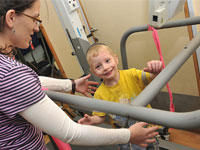Featured Staff Members - Chana Zolberg & Michal Yitzchaki
Six-year-old Tziri is an adorable, intelligent, happy girl with a great sense of humor who enjoys working on her computer in her spare time - despite her severe quadriplegic spastic impairment from cerebral palsy. At Meshi, she has a full day of kindergarten fun and lessons, coupled with intensive therapies to strengthen her body.  And like the vast majority of her 150+ classmates in the nursery and kindergarten, Tziri is fitted with equipment tailored for her specific needs, which must be continually adapted as she grows and develops. For Tziri (who steals your heart in a second), Meshi provided equipment this year that includes a specially-fitted chair with hip support, padded neck and shoulder support, and a portable table attachment for eating and studying; a tall "stander" with straps and armrests to make her upright, improve balance and internal organ function; a specially-designed walker with back support; a triangular "floor chair" where she can sit straight and play; a low bench that tilts to help her exercise; a "crawler" on wheels that she can sprawl across to scoot and retrieve Lego pieces; a tricycle tall enough to support her back, and the pièce deresistance-- a power wheelchair equipped with an easy-to-maneuver joystick for her to steer. On loan from Meshi for Tziri’s home use is a "Hart walker" that enables hands-free mobility, plus a manually operated wheelchair. The total price tag for equipment for this one child: $25,000.
And like the vast majority of her 150+ classmates in the nursery and kindergarten, Tziri is fitted with equipment tailored for her specific needs, which must be continually adapted as she grows and develops. For Tziri (who steals your heart in a second), Meshi provided equipment this year that includes a specially-fitted chair with hip support, padded neck and shoulder support, and a portable table attachment for eating and studying; a tall "stander" with straps and armrests to make her upright, improve balance and internal organ function; a specially-designed walker with back support; a triangular "floor chair" where she can sit straight and play; a low bench that tilts to help her exercise; a "crawler" on wheels that she can sprawl across to scoot and retrieve Lego pieces; a tricycle tall enough to support her back, and the pièce deresistance-- a power wheelchair equipped with an easy-to-maneuver joystick for her to steer. On loan from Meshi for Tziri’s home use is a "Hart walker" that enables hands-free mobility, plus a manually operated wheelchair. The total price tag for equipment for this one child: $25,000.
FINDING THE RIGHT EQUIPMENT FOR EACH CHILD
The women behind the organization and maintenance of Meshi kindergarten’s hundreds of pieces of specialized equipment are two young physical therapists, Chana Zolberg and Michal Yitzchaki, who take the daunting task in stride. "Essentially, we work together with Meshi’s interdisciplinary team. In Tziri’s case, over her three years at Meshi, we've constantly struggled to find devices suitable for her severe disabilities. We've brought in a parade of factory representatives in that search, and that's taken time. Fortunately Tziri has patience, and she is making progress that warms our hearts. Now we’re already getting prepared for the next stages," says Michal. She notes that Tziri lives in Rehovoth, and spends at least three hours traveling to Meshi and back each day. "Her parents want the best for her, and she has indeed made steady improvement over the past three years. Like every child at Meshi, Tziri is a precious, courageous child for whom we will do anything and everything in our power to help."
EARLY INTERVENTION IS THE KEY
Multiply Tziri’s needs by over 100 children—ranging in age from one to seven years—for the job description of Michal and Chana at Meshi. Both physical  therapists have been on the staff for eight years, with Michal specializing in special education and motor problems, and Chana in sports and physical fitness. "Of course, every child is different, and every piece of equipment must be fitted properly to support and strengthen damaged muscles and bones," Chana explains. "Before a child’s first day at Meshi, we go across the country for home visits to meet the parents and child and make our initial assessment. By September first, we’ve reviewed the needs of every child, and prepared basic equipment for each one--all color-coded by classrooms, labeled with their names, and ready in place for use."
therapists have been on the staff for eight years, with Michal specializing in special education and motor problems, and Chana in sports and physical fitness. "Of course, every child is different, and every piece of equipment must be fitted properly to support and strengthen damaged muscles and bones," Chana explains. "Before a child’s first day at Meshi, we go across the country for home visits to meet the parents and child and make our initial assessment. By September first, we’ve reviewed the needs of every child, and prepared basic equipment for each one--all color-coded by classrooms, labeled with their names, and ready in place for use."
A glance down any Meshi corridor or classroom reveals a seemingly endless array of metal, plastic and wooden rehab equipment of various small sizes and shapes. "It’s actually a very intricate science," Chana admits. "We are meticulous about cataloguing every single item of equipment, and we take full responsibility for seeing that each piece is maintained and repaired when necessary. Meshi demands that every child has the most ideal equipment he or she needs, and they truly spare no expense to acquire and maintain each piece."
Proper equipment is priceless for a child’s development, she stresses. "The key is early intervention. We’ve worked with toddlers who were paralyzed and couldn’t hold a walker. Their intensive therapy demanded a change of equipment at every stage of development. But we’ve seen it pay off, with many of these children walking today."





